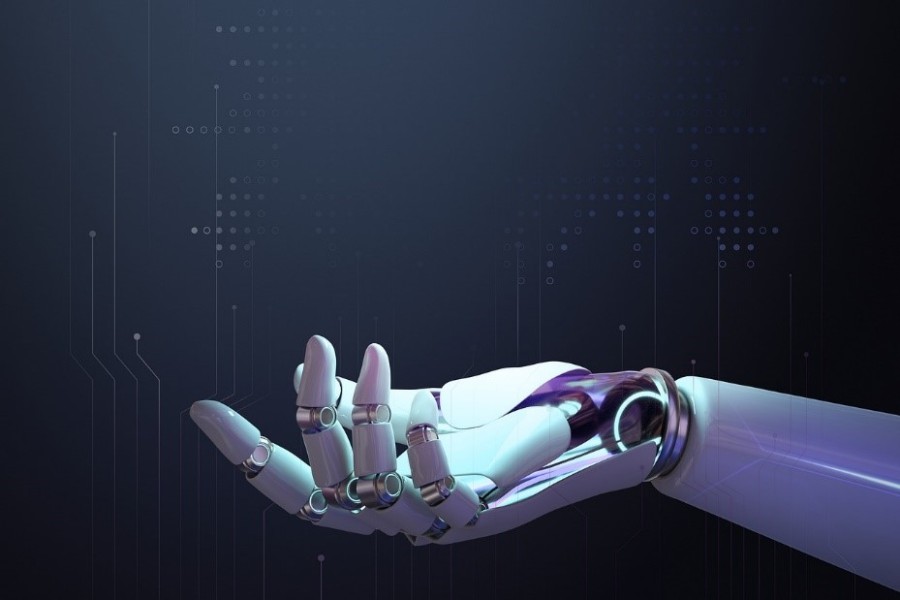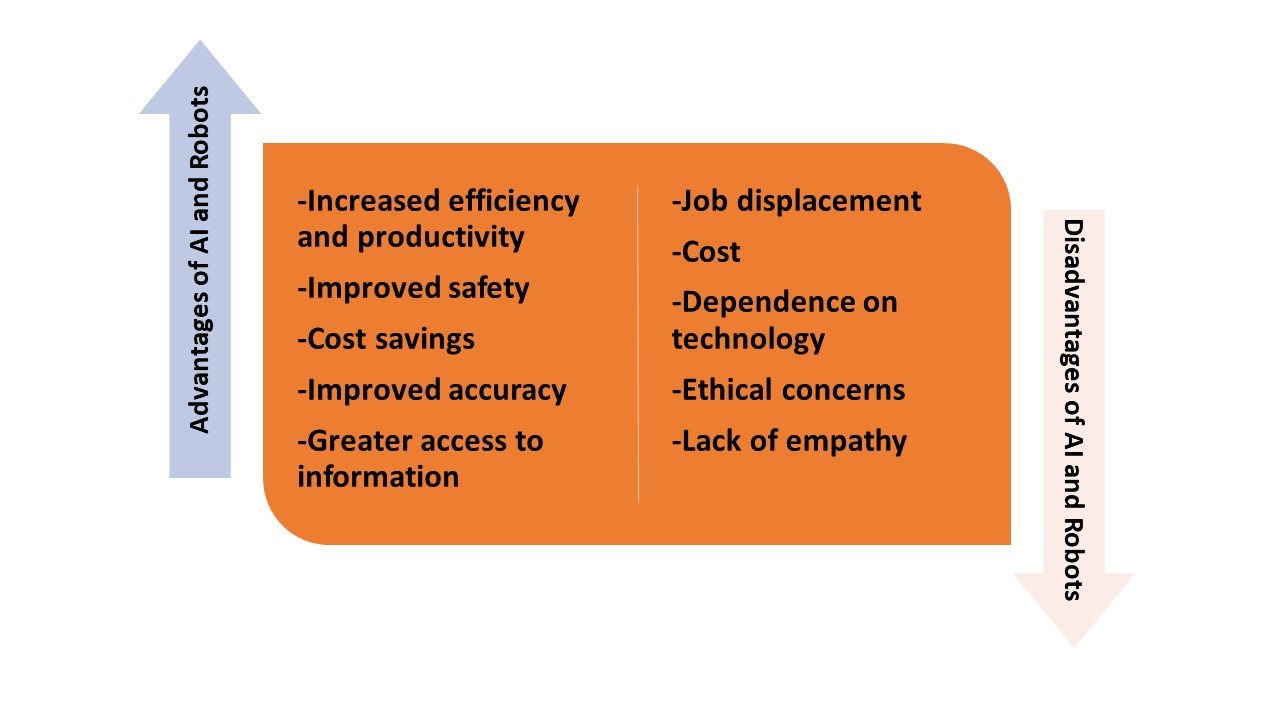Comments
- No comments found

Artificial Intelligence (AI) and robotics are two rapidly evolving fields that have the potential to revolutionize the way we live and work.
In recent years, advances in these areas have been breathtaking, and there is no doubt that they will continue to shape the future of humanity. In this chapter, we will explore the future of AI and robots, looking at the current trends, challenges, and opportunities.
One of the most significant trends in AI and robotics is the growth of machine learning. This has led to significant advances in areas such as image recognition, natural language processing, and decision-making.
Another trend is the integration of AI and robotics into various industries, including; healthcare and transportation are two areas where these technologies are expected to have a significant impact. However, they are also being used in fields such as manufacturing, agriculture, and even space exploration.
In terms of challenges, one of the biggest concerns is job displacement. As machines become more capable of performing tasks traditionally done by humans, many jobs will become obsolete. This could lead to significant economic and social disruption if not handled carefully. However, there is also the potential for new types of jobs to emerge, and for industries to be created around the development and maintenance of these technologies.
Another challenge is the ethical implications of AI and robotics. As machines become more intelligent, they will need to make decisions that affect human lives. This raises important questions about the responsibility of those who design and operate these machines, as well as the potential for machines to be used for malicious purposes. It is essential that we have an open and transparent dialogue about these issues, and that we work to ensure that these technologies are developed and used in a way that benefits humanity as a whole.
There are many opportunities for AI and robotics to improve our lives. From healthcare and transportation to education and entertainment, these technologies have the potential to make many aspects of our lives easier, safer, and more enjoyable. However, it is up to us to ensure that we use these technologies in a way that is responsible and equitable, and that we continue to push the boundaries of what is possible.
The advancement of robotics and AI technology is rapidly changing the job market. Many jobs that were once considered safe from automation are now at risk of being replaced by smart robots. Here are some examples of jobs that could be replaced by smart robots:
1. Manufacturing jobs: Robots have already taken over many manufacturing jobs, such as those in automotive production lines, and are increasingly being used in other manufacturing sectors.
2. Delivery and transportation jobs: With the development of self-driving cars and drones, many delivery and transportation jobs may become obsolete.
3. Customer service jobs: Chatbots and virtual assistants are increasingly being used to handle customer service inquiries, which could eventually lead to the replacement of human customer service representatives.
4. Data entry jobs: The use of optical character recognition (OCR) technology is making it easier to digitize paper documents and automate data entry tasks.
5. Accounting and bookkeeping jobs: AI-powered software can now automate many of the tasks traditionally done by accountants and bookkeepers, such as data entry and reconciling accounts.
6. Banking jobs: AI-powered chatbots and virtual assistants are being used to handle routine banking inquiries, which could eventually lead to the replacement of human bank tellers.
7. Medical jobs: Robots are increasingly being used in surgical procedures, and AI-powered software is being used to diagnose diseases and develop treatment plans.
8. Security jobs: Drones and security robots are being used to patrol and monitor large areas, which could eventually lead to the replacement of human security guards.
9. Cleaning jobs: Robots are being developed to perform a range of cleaning tasks, from vacuuming floors to cleaning windows.
10. Farming jobs: With the development of autonomous tractors and drones, many farming tasks could be automated in the near future.
It is important to note that while these jobs may be at risk of automation, new jobs will also be created in fields such as robotics engineering and software development. The key is to ensure that workers are equipped with the skills needed to adapt to the changing job market.
Artificial Intelligence (AI) and robots are changing the way we live and work. While they offer many benefits, there are also significant drawbacks to consider. We will explore the advantages and disadvantages of AI and robots.

Increased efficiency and productivity: One of the most significant advantages of AI and robots is their ability to perform tasks faster and more efficiently than humans. This can lead to increased productivity and lower costs for businesses.
Improved safety: Robots can be used to perform dangerous or hazardous tasks, such as exploring deep-sea environments or cleaning up nuclear waste. This can help keep humans out of harm's way and reduce the risk of accidents.
Cost savings: By using robots and AI, businesses can reduce labor costs and increase efficiency. This can lead to significant cost savings over time.
Improved accuracy: AI and robots can perform tasks with greater precision and accuracy than humans. This is particularly important in fields such as medicine and manufacturing, where small mistakes can have significant consequences.
Greater access to information: AI can be used to analyze vast amounts of data, making it easier for businesses and individuals to make informed decisions.
Job displacement: One of the most significant drawbacks of AI and robots is the potential for job displacement. As machines become more capable of performing tasks traditionally done by humans, many jobs may become obsolete.
Cost: While AI and robots can lead to cost savings over time, the initial investment can be significant. This can make it difficult for small businesses and individuals to adopt these technologies.
Dependence on technology: As we become more reliant on AI and robots, we may become less capable of performing tasks without their assistance. This could have long-term consequences for our ability to solve problems and make decisions independently.
Ethical concerns: AI and robots are increasingly being used in areas such as healthcare and law enforcement, raising important ethical questions about how these technologies are developed and used.
Lack of empathy: While AI and robots can perform tasks with great precision, they lack the empathy and emotional intelligence of humans. This can be a significant drawback in fields such as healthcare, where patients may need emotional support as well as medical care.
AI and robots offer many advantages, from increased efficiency and productivity to improved safety and accuracy. However, there are also significant drawbacks to consider, including job displacement, cost, and ethical concerns. As we continue to develop and adopt these technologies, it is essential that we carefully consider both the benefits and drawbacks and work to ensure that they are used in a way that benefits humanity as a whole. By doing so, we can create a future where AI and robots coexist with humans in a way that benefits everyone.
Overall, the future of AI and robotics is both exciting and uncertain. We are living in a time of rapid technological change, and it is up to us to shape the future in a way that benefits everyone. By working together, we can create a future where machines and humans coexist and thrive, and where the potential of AI and robotics is fully realized.
Ahmed Banafa is an expert in new tech with appearances on ABC, NBC , CBS, FOX TV and radio stations. He served as a professor, academic advisor and coordinator at well-known American universities and colleges. His researches are featured on Forbes, MIT Technology Review, ComputerWorld and Techonomy. He published over 100 articles about the internet of things, blockchain, artificial intelligence, cloud computing and big data. His research papers are used in many patents, numerous thesis and conferences. He is also a guest speaker at international technology conferences. He is the recipient of several awards, including Distinguished Tenured Staff Award, Instructor of the year and Certificate of Honor from the City and County of San Francisco. Ahmed studied cyber security at Harvard University. He is the author of the book: Secure and Smart Internet of Things Using Blockchain and AI.
Leave your comments
Post comment as a guest